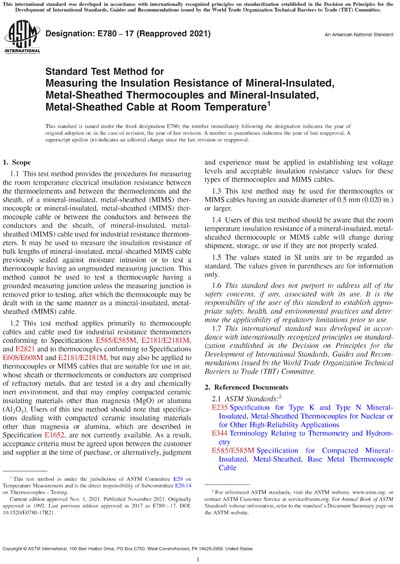Most recent
ASTM E780-17(2021)
Standard Test Method for Measuring the Insulation Resistance of Mineral-Insulated, Metal-Sheathed Thermocouples and Mineral-Insulated, Metal-Sheathed Cable at Room Temperature
1.1This test method provides the procedures for measuring the room temperature electrical insulation resistance between the thermoelements and between the thermoelements and the sheath, of a mineral-insulated, metal-sheathed (MIMS) thermocouple or mineral-insulated, metal-sheathed (MIMS) thermocouple cable or between the conductors and between the conductors and the sheath, of mineral-insulated, metal-sheathed (MIMS) cable used for industrial resistance thermometers. It may be used to measure the insulation resistance of bulk lengths of mineral-insulated, metal-sheathed MIMS cable previously sealed against moisture intrusion or to test a thermocouple having an ungrounded measuring junction. This method cannot be used to test a thermocouple having a grounded measuring junction unless the measuring junction is removed prior to testing, after which the thermocouple may be dealt with in the same manner as a mineral-insulated, metal-sheathed (MIMS) cable.
1.2This test method applies primarily to thermocouple cables and cable used for industrial resistance thermometers conforming to Specifications E585/E585M, E2181/E2181M, and E2821 and to thermocouples conforming to Specifications E608/E608M and E2181/E2181M, but may also be applied to thermocouples or MIMS cables that are suitable for use in air, whose sheath or thermoelements or conductors are comprised of refractory metals, that are tested in a dry and chemically inert environment, and that may employ compacted ceramic insulating materials other than magnesia (MgO) or alumina (Al2O3). Users of this test method should note that specifications dealing with compacted ceramic insulating materials other than magnesia or alumina, which are described in Specification E1652, are not currently available. As a result, acceptance criteria must be agreed upon between the customer and supplier at the time of purchase, or alternatively, judgment and experience must be applied in establishing test voltage levels and acceptable insulation resistance values for these types of thermocouples and MIMS cables.
1.3This test method may be used for thermocouples or MIMS cables having an outside diameter of 0.5 mm (0.020 in.) or larger.
1.4Users of this test method should be aware that the room temperature insulation resistance of a mineral-insulated, metal-sheathed thermocouple or MIMS cable will change during shipment, storage, or use if they are not properly sealed.
1.5The values stated in SI units are to be regarded as standard. The values given in parentheses are for information only.
1.6This standard does not purport to address all of the safety concerns, if any, associated with its use. It is the responsibility of the user of this standard to establish appropriate safety, health, and environmental practices and determine the applicability of regulatory limitations prior to use.
1.7This international standard was developed in accordance with internationally recognized principles on standardization established in the Decision on Principles for the Development of International Standards, Guides and Recommendations issued by the World Trade Organization Technical Barriers to Trade (TBT) Committee.
Content Provider
ASTM International [astm]






